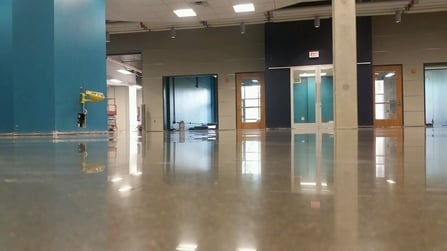
If you are looking for an attractive and cost-effective flooring option for your facility, polished concrete may be a great fit for your needs. Polished concrete floors are durable, low-maintenance, relatively slip-resistant, and aesthetically pleasing, plus they can last many years if well maintained.
There are a few misconceptions about polished concrete, however, that sometimes prevent them from being considered as an option. Here are some common misconceptions and the truth behind them:
“Polished concrete is too slippery.”
Despite its slick appearance, polished concrete provides the same level of grip as unpolished concrete. It can actually be less slippery than tile or marble, especially in wet conditions.
That’s because concrete’s unique porous surface prevents polished concrete from being slippery when wet. However, it can become difficult to walk on when covered in fine powder or dust, so it’s not recommended for environments that deal with sawdust, pottery production, or other powdery products.
“Polished concrete is cold during winter and hot during summer.”
Fluctuations in temperature are common for concrete floors in basements, garages, and other spaces that are not climate controlled. If you’re considering polishing the concrete in your unheated warehouse, for example, then yes, the floor’s temperature will vary dramatically.
But in a lobby, factory, or retail space that’s air conditioned or heated, the floor will not have a significant impact on your room’s temperature (though it may feel cooler to bare feet than something such as carpet).
“Polished concrete floors are hard to maintain.”
Actually, polished concrete floors are easier to maintain than untreated concrete, which sheds fine dust. The polished surface sheds significantly less, and its smooth finish makes effective sweeping easier.
We recommend at least weekly sweeping, as well as mopping with a PH-neutral soap. Stains from oils or liquids may require a poultice to remove.
After a couple of years, the floor’s shine may dull a little due to foot traffic, but generally a quick re-buffing will set it looking like new.
“The stain will wear off.”
Concrete can be colored using a dye or stain prior to polishing for additional visual interest. This coloring agent is not merely a paint that sits on the surface of a floor; rather it penetrates the porous surface and extends deeply into the concrete. Thus the color doesn’t easily rub away or chip off. (As case in point, the dye is applied before the surface is ground and polished and still remains!)
“Polished concrete is more susceptible to cracking.”
Keep in mind that all concrete floors will crack, whether polished, coated, or untreated. A concrete slab cracks as part of the initial curing process, and it will crack again over time. Polishing will not change this aspect of concrete’s nature, though it may draw attention away from it.
Cracks can be somewhat controlled by sawing joints into the surface of the floor, and existing cracks can be filled and sealed to prevent further damage.
Want to know if Polished Concrete is the right choice for your facility? We can help!
If you’re located in the Southeastern U.S. and are trying to decide which flooring solution is right for your company, someone from CPC Floor Coatings can visit your facility and help you make an informed decision. Contact us online for a free consultation, or click the banner below to access our concrete polishing information hub.

